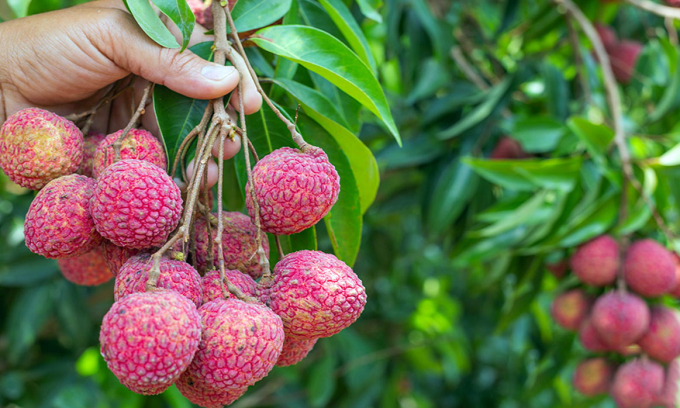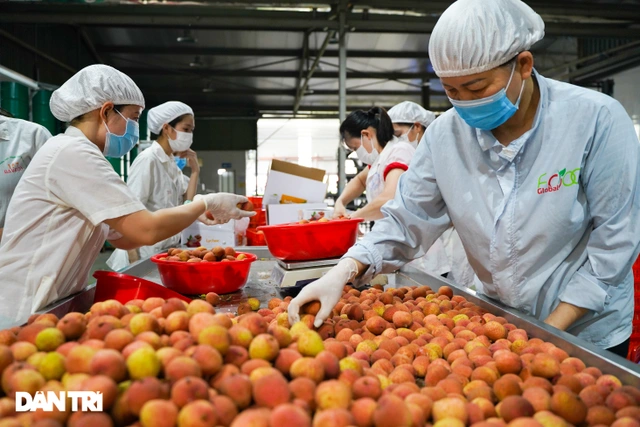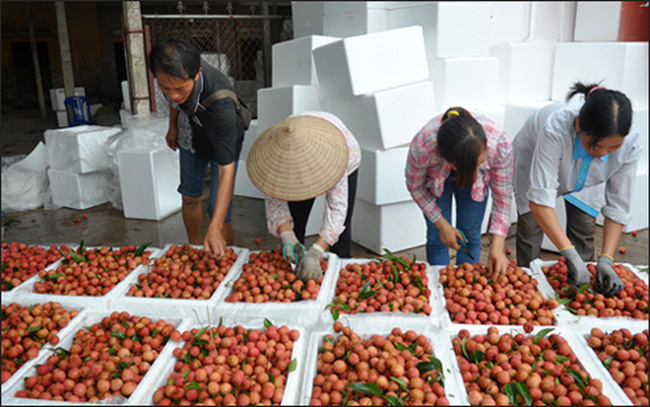This article will provide instructions on how to pack lychee for export and how to preserve it to ensure product quality.
1. How to preserve lychee for export
Lychee is a relatively popular agricultural product in our country. This fruit is grown mainly in northern provinces such as Bac Giang, Hai Duong, etc. Because it is a tropical fruit, the storage life of lychee is often very short. To ensure that exported lychee retains its freshness, it is necessary to apply appropriate preservation methods. Below are methods of preserving lychee for export that businesses can refer to.

Packaging specifications of lychee for export
–> See more: Instructions on the latest lychee export procedures
1.1 Check and treat lychee with 0.2% Ozone water
When lychees reach a certain level of maturity, farmers will harvest them. Then, people will select lychees that meet the appearance standards and irradiate them for about an hour. Next, the lychee is soaked in 0.2 % ozone water to help remove dirt and harmful bacteria. Finally, after soaking for a few minutes, the lychees will be labeled and sealed.
1.2 Store in a cold room at appropriate temperature and humidity
After being harvested, the lychee will be allowed to dry by using a fan to blow it. Next, people put the lychee into a cold room to preserve it at a temperature and humidity appropriate to the moisture standards of the lychee. Normally the ideal temperature conditions will be 4 - 5 degrees Celsius, air humidity 90 - 95%. During the process of preserving exported lychees, the temperature and humidity can change depending on the customer's specific requirements and the condition of the lychee.
- Store in cold room
- Store fabric in a cold room

Packaging specifications of lychee for export
Note:
- Lychees are not like some other fruits, so plant protection wax cannot be used.
- Normally people will not use foam nets to preserve exported fabric.
- Businesses prioritize using cartons to store export fabrics with ventilation holes instead of foam boxes.
2. Packaging process of lychee for export
Packaging lychee for export is a process that is very strictly managed by businesses. This process does not require high technology but greatly affects the standards of lychee export to foreign markets. Below is the export packaging process for lychee that businesses often apply:

Packaging specifications of lychee for export
- Step 1: First, people will harvest lychee based on the requirements of the export market such as color, size, etc. Next, the lychee is placed into baskets with holes to prepare for processing before processing. preserve. This process absolutely does not use water and even requires a fan to help the fabric drain faster.
- Step 2: The fabric is disinfected and packed into professional boxes. Most businesses will choose to pack exported lychees into plastic baskets or cartons with holes in them. This issue depends on finances as well as the specific requirements of each market. For example, if exported to Japan, it is packed into cartons with a weight of 5 - 18kg. This is the regulation of the Plant Protection Department and Japan for imported lychees.
- Step 3: After packing into boxes, the fabric will be sterilized by stacking on pallets. People put lychees through sterilization equipment to ensure a maximum product volume of 38%, the volume of the storage space. The entire processing process is fully automated by businesses. Finally, the fabric will be put into cold storage to be transported to potential fabric export markets such as Japan, China, EU...
WOMENunmarketableDear customers, what about vughNg mahcbaht any information live above, please kunmarketabletnohivUhi our company deh nhahNDuhcsUgh phmoundcvmound tahn mind – tUh vahn miEhn fee, hoh pbelch 24/7.
–> If you have any questions, please contact hotline: 0903712368 for free consultation.
—– RELATED ARTICLES:

